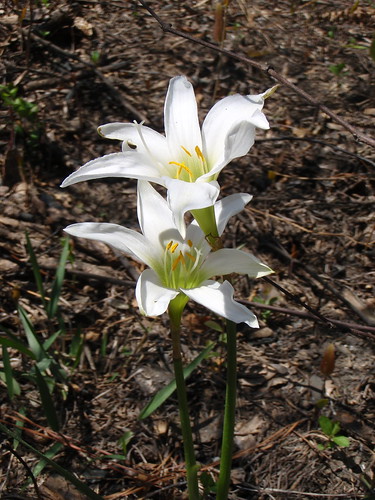In case anybody has forgotten Hurricane Helene:
This is directly in front of our house. Continue reading
In case anybody has forgotten Hurricane Helene:
This is directly in front of our house. Continue reading
A week after Hurricane Idalia, this Treat’s Rain Lily was blooming.
Normally they bloom in the spring. Continue reading
These lilies sprung up just in time for the weekend cold snap.
![[One and two Treat's Rain Lilies @ OPF 2023-02-18]](http://www.okraparadisefarms.com/pictures/2023-02-18--rain-lilies/many.jpg)
One and two Treat’s Rain Lilies @ OPF 2023-02-18
Treat’s rain lily, Zephyranthes atamasca var. treateiae, is a special variety that mostly grows in counties on either side of the GA-FL line. I hear there are also some in Louisiana and Alabama. Continue reading
A sure sign of spring: Treat’s rain lily.
Zephyranthes atamasca var. treateiae these days is classified as an amaryllis.
This is a special native variety of Atamasco lily, Zephyranthes atamasca, that only grows in counties on either side of the GA-FL line, plus maybe some in Alabama. According to Flora of North America (eFloras.org), Continue reading
Update 2024-06-10: Yellow Dog’s rosemallow, three years later 2024-06-09
On our daily walk to the field, Yellow Dog encountered the first Swamp Rosemallow of the year, and perhaps the last Treat’s Rain Lily, while the Beautyberry remains in bloom.
![[Halberd-leaf rosemallow, Yellow Dog]](http://www.okraparadisefarms.com/pictures/2021-06-12--rosemallow-yellow-dog-beautyberry-rain-lily/20210612_074654.jpg)
Halberd-leaf rosemallow, Yellow Dog
A small lily that grows only in counties along the Georgia-Florida border, and maybe in a few in Alabama: Treat’s Rain Lily, Zephyranthes atamasca var. treateiae. These days it’s classified as an amaryllis.
-jsq
Here’s a more normal-looking specimen: Continue reading
More pictures in the flickr set. Pictures by John S. Quarterman, Lowndes County, Georgia, 17 March 2011.
Also pictures from previous years.
-jsq
 You may know these as Easter lilies, or “those lilies that grow in the ditches by the road in the spring.”
It turns out their real name is Treat’s Rain Lily,
and they are a native of south Georgia and north Florida,
plus a bit of Alabama, and don’t grow anywhere else.
We’ve seen them in Georgia counties along the Florida border
as far west as Cairo, but not any farther north.
Here’s
much more about these lilies.
You may know these as Easter lilies, or “those lilies that grow in the ditches by the road in the spring.”
It turns out their real name is Treat’s Rain Lily,
and they are a native of south Georgia and north Florida,
plus a bit of Alabama, and don’t grow anywhere else.
We’ve seen them in Georgia counties along the Florida border
as far west as Cairo, but not any farther north.
Here’s
much more about these lilies.
They really like where we burned this spring in the woods:
The red flags mark where we transplanted some longleaf pine seedlings.
Pictures by Gretchen Quarterman, 2-3 April 2010, Lowndes County, Georgia.